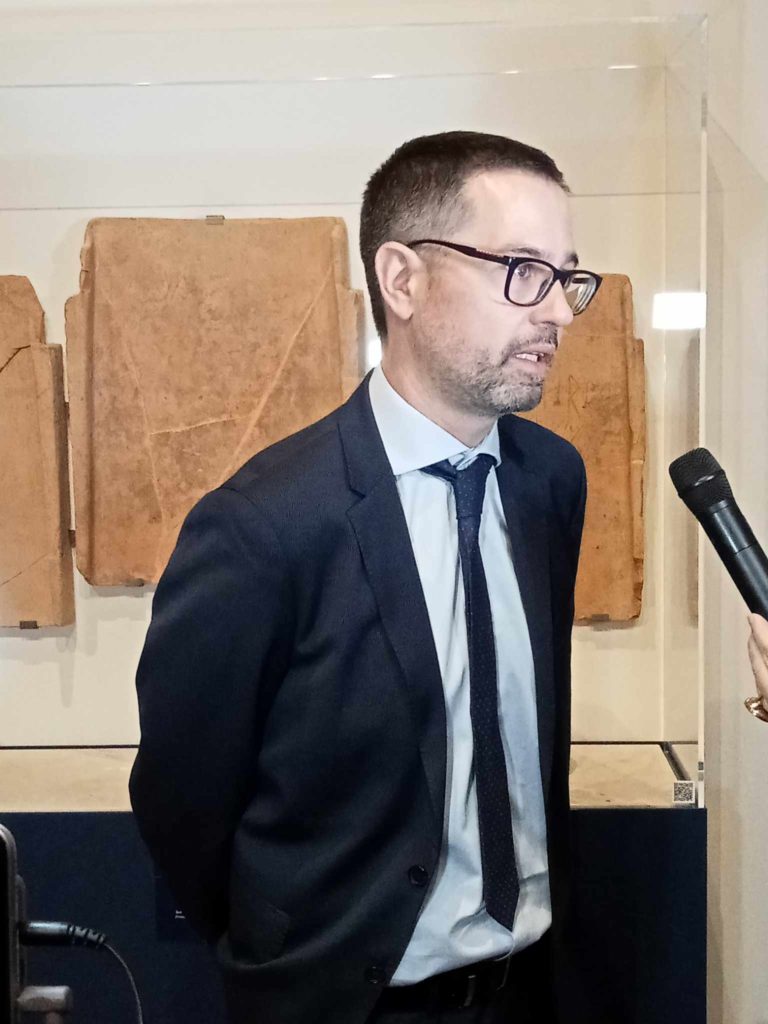Grande emozione per l’inaugurazione di una delle esposizioni più importanti del 2024 per il Museo Mann, “Gli dei ritornano” che vede protagonisti i bronzi scoperti a San Casciano dei bagni, nella provincia di Siena (fino al 30 giugno). Una delle scoperte più importanti degli ultimi 52 anni, rispetto a quella dei Bronzi di Riace che avvenne nel 1972. Episodi che sono un punto cruciale e di svolta nella storia dell’archeologia e non solo.

L’esposizione, curata da Massimo Osanna Direttore generale Musei del MiC, si trova nelle nuove sale del Museo al terzo piano, destinate ad accogliere da oggi in poi le mostre temporanee.
L’atmosfera è quella avvolgente dell’acqua, l’elemento che ha fatto si che tutta la bellezza esposta si potesse conservare così a lungo. I reperti infatti, ritrovati nel 2022 e i più recenti nel 2023, erano all’interno di quello che fu il santuario termale etrusco, e poi romano, del Bagno Grande.
Storie sepolte che sono un unicum, come la base del donario in travertino con un’iscrizione bilingue in etrusco e latino, cosa davvero molto rara e che testimonia l’uso dell’etrusco ancora in età augustea; oppure il pendente a forma pesciolino in preziosissimo cristallo di rocca, la generosa quantità di monete e i particolarissimi ex-voto.

«La bellezza sta anche nelle piccole cose» come sottolinea il direttore scientifico degli scavi Jacopo Tabolli che esorta proprio a godere dei dettagli di queste opere straordinarie. «Inoltre la mostra è la punta dell’iceberg di un lavoro lungo e complesso che a tutt’oggi portiamo avanti e che vede la collaborazione tra Università, archeologici e figure professionali provenienti da ogni parte del mondo. La cooperazione è l’elemento chiave per far sì che la ricerca vada avanti nel miglior modo possibile».


Ed è dello stesso avviso anche la giovane sindaca di San Casciano, Agnese Carletti, che confida in un rilancio del piccolo comune in chiave non esclusivamente turistica ma piuttosto come punto focale per gli studi nell’ambito. «Grazie all’accordo di valorizzazione firmato tra il Ministero della Cultura, la Regione Toscana, il Comune di San Casciano e l’Università per Stranieri di Siena, ci sarà il museo permanente nel Palazzo dell’Arcipretura di San Casciano (appena acquistato per lo scopo), che ospiterà i reperti e altre collezioni storiche del territorio. Verrà costituito un Hub proprio per la ricerca e speriamo di accogliere studenti e studiosi che possano trovare qui un centro nevralgico e di approfondimento per i loro percorsi e lavori».
Un’occasione straordinaria per fare un viaggio indietro nel tempo che sicuramente non sarà l’unico, viste le continue sorprese che ci riserva San Casciano.
Per saperne di più
https://mann-napoli.it/
Mann/ “The Gods return,” bronzes from San Casciano dei bagni on display in Naples ( until June 30th). The past in the immersive atmosphere of water
Great excitement for the opening of one of the most important exhibitions of 2024 for the Mann Museum, “The Gods return”, with the bronzes discovered in San Casciano dei bagni, in the province of Siena (until June 30th). One of the most important discoveries in the last 52 years, compared to that of the Riace bronzes in 1972. Episodes that represent a crucial and turning point in the history of archaeology and beyond.
The exhibition, curated by Massimo Osanna, director general of the museums of the MiC, is located in the museum’s new spaces on the third floor, which will now host temporary exhibitions.
The atmosphere is that of water, the element that has allowed all the beauty on display to be preserved for so long. In fact, the artifacts found in 2022 and the most recent ones in 2023 were found inside the former Etruscan and later Roman sanctuary of the Bagno Grande.
Buried stories that are unique, such as the travertine donatory base with a bilingual inscription in Etruscan and Latin, which is very rare indeed and testifies to the use of the Etruscan language even in the Augustan age; or the fish-shaped pendant made of very precious rock crystal, the generous quantity of coins and the very special ex-votos.
“Beauty is also in the small things,” says Jacopo Tabolli, the scientific director of the excavations, who invites us to enjoy the details of these extraordinary works. “Moreover, the exhibition is the tip of the iceberg of a long and complex work that we continue to carry out today, involving the collaboration of universities, archaeologists and professionals from all over the world. Working together is key to ensuring that research continues to progress in the best possible way”.
The young mayor of San Casciano, Agnese Carletti, shares this opinion and believes in a revival of the small town in a perspective that is not exclusively touristic, but rather as a focal point for studies in the field. “Thanks to the enhancement agreement signed between the Ministry of Culture, the Tuscan Region, the Municipality of San Casciano and the University for Foreigners of Siena, there will be a permanent museum in the Palazzo dell’Arcipretura of San Casciano (just acquired for this purpose), which will house the artifacts and other historical collections of the area. It will be a center dedicated to research, and we hope to welcome students and scholars who will find here a nerve and a deep base for their paths and their work”.
An extraordinary opportunity to take a trip back in time, which will certainly not be the only one, given the constant surprises that San Casciano has in store for us.
Read more at
https://mann-napoli.it/










